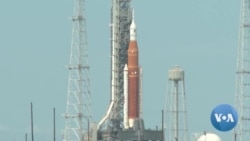ຈົນເຖິງຂະນະນີ້, ອົງການ NASA ຍັງບໍ່ສາມາດດໍາເນີນພາລະກິດຍິງຈະຫຼວດອາຣ໌ເຕມິສ ລູກທໍາອິດໄດ້ເລີຍ, ອັນໄດ້ນໍາໄປສູ່ການກວດກາເພີ້ມເຕີມແບບລະອຽດທີ່ສຸດ ຢູ່ໃນໂຄງການ ທີ່ມີລາຄາຫຼາຍພັນລ້ານໂດລາ ກາຍງົບປະ ມານທີ່ໄດ້ກໍານົດໄວ້ ແລະກໍຊ້າກວ່າກໍານົດການຫຼາຍປີ ທີ່ຈະສົ່ງນັກບິນອະວະ ກາດໄປລົງເທິງດວງເດືອນອີກຄັ້ງ. ແຄນ ຟາຣາບອດ (Kane Farabaugh), ນັກຂ່າວ VOA ລາຍງານວ່າ ເຖິງແມ່ນຈະມີການຍົກເລີກໃນການຍິງສົ່ງກໍຕາມອົງການອະວະກາດຂອງສະຫະລັດຫວັງວ່າ ຈະມີການສົ່ງຍານອະວະກາດອາຣ໌ເຕມິສ ຂຶ້ນສູ່ອະວະກາດ ພາຍໃນທ້າຍປີນີ້. ທິບສຸດາ ມີລາຍລະອຽດມາສະເໜີທ່ານໃນອັນດັບຕໍ່ໄປ.
ຈົນເຖິງຕອນນີ້ ການລໍຖ້າເບິ່ງ ການປ່ອຍຍານອະວະກາດອາຣ໌ເຕມິສ 1 ໄປດວງເດືອນ ແມ່ນເປັນທີ່ໜ້າຜິດຫວັງທີ່ສຸດ ສໍາລັບຜູ້ລໍຖ້າເບິ່ງ ຄື ມາກ ແຟຣັງໂກ (Mark Franko), ເຊິ່ງລາວໄດ້ກ່າວວ່າ:
“ຂ້ອຍຫວັງວ່າຈະສໍາພັດກັບຄວາມຮູ້ສຶກຂອງສຽງທີ່ນອງນັນ ແລະສຽງທີ່ມີພະ ລັງ. ຂ້ອຍຄິດວ່າ ມັນຈະເປັນສິ່ງທີ່ໜ້າສົນໃຈຫຼາຍ.”
ແຟຣັງໂກ ແລະເພື່ອນຂອງລາວ ພາກັນວາງແຜນມາວ່າຈະເບິ່ງການປ່ອຍຍານອະວະກາດ ຢູ່ດ້ານຫຼັງຂອງຮ້ານອາຫານ ໃກ້ໆກັບແຫຼມຄານາເວີຣາລ, ແຕ່ວ່າ ຍ້ອນການຮົ່ວໄຫຼຂອງລະບົບເຊື້ອໄຟແລະບັນຫາດ້ານອື່ນໆ ເຮັດໃຫ້ຕ້ອງເລື່ອນ ເວລາສອງເທື່ອແລ້ວ ໃນການປ່ອຍລະບົບຈະຫຼວດທີ່ມີພະລັງທີ່ສຸດເທົ່າທີ່ເຄີຍສ້າງຂຶ້ນມາ ໄປຍັງອະວະກາດ.
ນາງແມຣີ ແຈນ ແພັດເຕີສັນ (Mary Jane Patterson), ຜູ້ທີ່ມາເບິ່ງການປ່ອຍຍານອະວະກາດອາຣ໌ເຕມິສທີ 1 ກ່າວວ່າ:
“ຂ້ອຍຄິດວ່າ ພວກເຂົາເຈົ້າຄວນເອົາຍານດັ່ງກ່າວ ກັບເຂົ້າມາ ໃນສະຖານທີ່ ແລະດໍາເນີນການກວດກາໃຫ້ລະອຽດຄັກແນ່ເສຍກ່ອນ ແລ້ວຈຶ່ງນໍາອອກໄປດໍາເນີນການອີກຄັ້ງ. ຂ້ອຍຮູ້ສຶກວ່າມັນຢາກໄວເກີນໄປທີ່ຈະປ່ອຍຍານອະວະກາດໃນທັນທີ ຫຼັງຈາກທີ່ຫາກໍພົບກັບບັນຫາໃນຊ່ວງທໍາອິດ, ແລະຂ້ອຍຄິດວ່າ ຈະເປັນຝ່າຍພົວພັນ ຫຼືຝ່າຍໃດໆກໍຕາມ ພວກເຂົາໄດ້ພະຍາຍາມທີ່ຈະຕິດຊອງຈົດໝາຍແລ້ວ ແຕ່ນະເວລາດຽວກັນ ພວກເຂົາເຈົ້າບໍ່ສາມາດເຮັດຫຍັງໄດ້.”// “ຂ້ອຍບໍ່ຄິດວ່າ ພວກເຈົ້າມີຄວາມລະມັດລະວັງຫຼາຍໂພດ.”
ທ່ານສແຕນ ເລິບ (Stan Love), ນັກບິນອະວະກາດຂອງອົງການ NASA ກ່່າວວ່າ:
6:37:50 “ນີ້ແມ່ນຄັ້ງທໍາອິດທີ່ພວກເຮົາໄດ້ປ່ອຍຈະຫຼວດ ແລະຍານອະວະກາດນີ້, ສະນັ້ນ ມັນກໍມີຫຼາຍໆ ຫຼາຍໆ ຢ່າງທີ່ຜິດພາດໄດ້. ນີ້ເປັນພຽງຖ້ຽວບິນຝຶກຊ້ອມເທົ່ານັ້ນ, ຢ່າຄາດຫວັງຫຍັງສູງເກີນໄປ.”
ແຕ່, ດ້ວຍຈໍານວນນັກທ່ອງທ່ຽວທີ່ໄປເຕົ້າໂຮມກັນຢ່າງຫຼວງຫຼາຍຢູ່ໃນລັດຟລໍຣິດາ ໃນຄວາມພະຍາຍາມທີ່ຈະປ່ອຍຍານອະວະກາດແຕ່ລະຄັ້ງ ບວກກັບຈໍານວນຜູ້ລາຍງານຂ່າວທີ່ມາຈາກທົ່ວໂລກ, ທ່ານ ເລິບ ຮັບຮູ້ວ່າຄວາມຄາດຫວັງທັງຫຼາຍເຫຼົ່ານັ້ນແມ່ນສູງ, ເນື່ອງຈາກພາກສ່ວນຂອງໂຄງການທີ່ມີລາຄາສູງ.
ລາຄາຂອງລູກຈະຫຼວດ ແລະໂຕໃຊ້ສໍາລັບຂັບເຄື່ອນເພື່ອສົ່ງຍານອະວະກາດ ໂອຣຽນ ຂຶ້ນສູ່ອະວະກາດ ມີລາຄາທີ່ເພີ້ມສູງຂຶ້ນຈາກ 10 ຕື້ໂດລາ ມາເປັນ 20 ຕື້ໂດລາ. ໃນການປ່ອຍຍານແຕ່ລະຄັ້ງ ຈະມີມູນຄ່າສູງເຖິງ 4.1 ຕື້ໂດລາ. ຜູ້ກວດກາລາຍລະອຽດຕ່າງໆຂອງອົງການ NASA ຄາດວ່າ ເມື່ອຮອດໄລຍະເວລາທີ່ນັກບິນອະວະກາດໄປຢຽບໜ້າຜິວຂອງດວງເດືອນ ເມື່ອນັ້ນລາຄາຂອງໂຄງການອາຣ໌ເຕມິສ ຈະເພີ້ມຂຶ້ນສູງຮອດ 93 ຕື້ໂດລາ, ເຊິ່ງມີເປົ້າໝາຍໃສ່ປີ 2025.
ນັ້ນ, ຖ້າຫາກອົງການ NASA ສາມາດສົ່ງຍານອະວະກາດທີ່ບໍ່ມີຄົນຂັບອອກຈາກໜ້າໂລກພາຍໃນທ້າຍປີນີ້.
ທ່ານດຸກ ເຮີລີ (Doug Hurley), ອະດີດນັກບິນອະວະກາດຂອງອົງການ NASA ຈາກນອດທຣັອບ ກຣໍາແມນ (Northrop Grumman) ກ່າວວ່າ:
“ແຕ່ພວກເຮົາກໍມີຄວາມທ້າທາຍຫຼາຍອັນ. ພວກເຮົາຕ້ອງເຮັດໃຫ້ໝັ້ນໃຈວ່າ ຍານພາຫະນະຂອງພວກເຮົາມີຄວາມພ້ອມທີ່ຈະອອກເດີນທາງ. ພວກເຮົາຕ້ອງເຮັດໃຫ້ແນ່ນອນວ່າມັນມີຄວາມປອດໄພສໍາລັບພະນັກງານຂອງພວກເຮົາ, ແລະ ທັງໝົດເຫຼົ່ານັ້ນ ກໍພຽງແຕ່ຕ້ອງໄດ້ໃຊ້ເວລາ.”
ທ່ານດຸກ ເຮີລີ ແມ່ນນັກບິນອະວະກາດເບ້ຍບໍານານຂອງອົງການ NASA ຜູ້ທີ່ໄດ້ບິນຂຶ້ນໄປກັບຍານອະວະກາດຄົນຂັບດຣາກອນ (Crew Dragon) ຂອງບໍລິສັດ ສເປດເອັກສ໌ (Space X) ສູ່ສະຖານີຍານອະວະກາດນານາຊາດ ເປັນຄັ້ງທໍາອິດ. ປັດຈຸບັນ ທ່ານເຮັດວຽກໃຫ້ແກ່ ນອດທຣັອບ ກຣໍາແມນ, ເຊິ່ງເປັນນຶ່ງໃນຜູ້ທີ່ມີສັນຍາຈ້າງເຮັດວຽກກັບໂຄງການຍານອະວະກາດອາຣ໌ເຕມີສ.
ນັກຂ່າວແຄນຖາມ ທ່ານດຸກ ເຮີລີ ວ່າ:
“ທ່ານກ່າວຫຍັງກັບບັນດາຜູ້ຄົນທີ່ພາກັນເວົ້າວ່າ ມັນມີລາຄາທີ່ເກີນກວ່າງົບປະມານທີ່ກໍານົດໄວ້ ແລະຫຼ້າຊ້າກວ່າເວລາທີ່ໄດ້ວາງໄວ້?”
ທ່ານດຸກຫົວອອກມາ ແລ້ວຕອບວ່າ:
“ຂ້າພະເຈົ້າໄດ້ຍິນແບບນີ້ມາຕະຫຼອດ ໃນຊ່ວງຊີວິດການເຮັດວຽກຂອງຂ້າພະເຈົ້າ. ເຮືອບິນທຸກລໍາທີ່ຂ້າພະເຈົ້າມີສ່ວນຮ່ວມ, ຍານອະວະກາດທຸກລໍາທີ່ຂ້າ ພະເຈົ້າໄດ້ດໍາເນີນງານນໍາ. ພວກເຮົາກໍໄດ້ຍິນແບບນັ້ນເຊັ່ນກັນ ໃນລະຫວ່າງທີ່ພວກເຮົາພະຍາຍາມປ່ອຍຍານອະວະກາດຄົນຂັບດຣາກອນ ອອກບິນ, ມັນເປັນໄລຍະເວລາ 6 ປີມາແລ້ວ ຈາກໄລຍະເວລາທີ່ພວກເຮົາໄດ້ຮັບຜົນຕອບແທນທີ່ດີໃນຊ່ວງທີ່ພວກເຮົາເຮັດວຽກໃນການບິນດັ່ງກ່າວ. ມັນຕ້ອງໃຊ້ເວລາໃນການສ້າງເຄື່ອງຍົນທີ່ຊັບຊ້ອນຕ່າງໆເຫຼົ່ານີ້, ແຕ່ມັນກໍມີຜົນຕອບແທນທີ່ຄຸ້ມຄ່າດີເຊັ່ນກັນ.”
ໃນຂະນະທີ່ອົງການ NASA ແກ້ໄຂບັນຫາຫຍຸ້ງຍາກຕ່າງໆ ໃນລະຫວ່າງການຊັ່ງຊາເບິ່ງຄວາມສ່ຽງຢ່າງລະມັດລະວັງໃນການປ່ອຍຍານອະວະກາດອາຣ໌ເຕມິສ, ຄ່າໃຊ້ຈ່າຍບໍ່ແມ່ນພຽງແຕ່ປັດໄຈອັນດຽວ. ທ່ານເດວິດ ເລໂນລ (David Reynolds) ກ່າວວ່າ ອະນາຄົດທັງໝົດຂອງຍານອະວະກາດ ແມ່ນຂຶ້ນຢູ່ກັບຄວາມພະຍາຍາມໃນການທົດລອງປ່ອຍຍານອະວະກາດທີ່ບໍ່ມີຄົນຂັບກັບຄືນໄປດວງເດືອນໃນຄັ້ງທໍາອິດນີ້.
ທ່ານເດວິດ ເລໂນລ, ຮອງຜູ້ຈັດການຝ່າຍຂັບເຄື່ອນເຄື່ອງຍົນ SLS Boosters ກ່າວວ່າ:
“ເມື່ອພວກເຈົ້າໝາຍເຄື່ອງໝາຍໃສ່ແກັດຕ່າງໆ, ພວກເຈົ້າຈະຊື້ຄວາມສ່ຽງໃຫ້ແກ່ລູກເຮືອເມື່ອດໍາເນີນການບິນ. ແລະສະນັ້ນ, ເມື່ອພວກເຈົ້າມີຄວາມໝັ້ນໃຈ, ແລະພວກເຮົາກໍມີການຕັດສິນໃຈວ່າ ມັນມີຄວາມປອດໄພພຽງພໍທີ່ຈະບິນພ້ອມດ້ວຍນັກບິນ, ເມື່ອນັ້ນ ພວກເຮົາຈຶ່ງພິຈາລະນາໄດ້ວ່າ ພະລະກິດດັ່ງກ່າວນີ້ປະ ສົບຜົນສໍາເລັດ.”
ມາກ ແຟຣງໂກ ຈໍາເປັນຕ້ອງໄດ້ກັບເມືອເມືອງ ແທັມເປ (Tempe) ໃນລັດແອຣິໂຊນາ ກ່ອນມີການປ່ອຍຍານອະວະກາດທີ່ສໍາຄັນໃນຄັ້ງຕໍ່ໄປ. ລາວຕັ້ງຂໍ້ສັງເກດວ່າ ຖ້າຄວາມພະຍາຍາມໃນການໄປເບິ່ງ ການປ່ອຍຍານອະວະກາດ ອາຣ໌ເຕມິສ ຄັ້ງທໍາອິດດ້ວຍຕົນເອງນັ້ນ ຫາກຄຸ້ມຄ່າຫຼືບໍ່, ເຊິ່ງລາວໄດ້ກ່າວວ່າ:
“ຖ້າເຈົ້າເບິ່ງຜ່ານທາງໂທລະພາບ, ມັນອາດຈະເຫັນໄດ້ໃກ້ກວ່ານີ້.”
ປັດຈຸບັນ, ອົງການ NASA ກໍາລັງມອງຫາຄວາມເປັນໄປໄດ້ຫຼາຍຊ່ອງທາງໃນການປ່ອຍຍານອະວະກາດຈາກໄລຍະລະຫວ່າງທ້າຍຂອງເດືອນກັນຍາ ໄປຫາເດືອນຕຸລາ ທີ່ຈະມາເຖິງນີ້.
NASA has so far been unable to launch its first Artemis mission, bringing added scrutiny to a program that is billions of dollars over budget and years behind schedule in returning humans to the moon. VOA’s Kane Farabaugh reports that despite scrubbed launches, the U.S. space agency hopes to get the Artemis program off the ground by the end of the year.
Watching the launch of NASA’s Artemis 1 rocket to the moon is — so far — an exercise in frustration for onlookers like Mark Franko.
Mark Franko, Artemis 1 Watcher
“I was hoping to feel the noise and the power and the sound. It would have been pretty interesting to see, I think.”
Franko and his friends planned to watch the launch behind a restaurant near Cape Canaveral, but fuel leaks and other issues have postponed — twice — the most powerful rocket system ever created from taking off.
Mary Jane Patterson, Artemis 1 Watcher
“I think that they should bring it back to the building and really check it out completely and then go again. I feel like it was too soon to go off after the first problem, and I think that whether it was PR or whatever, they were trying to push the envelope, but at the same time, they can’t.” // “I don’t think you can be too cautious.”
Stan Love, NASA Astronaut
6:37:50 “It’s the first time we’ve flown this rocket and this capsule, so there are many, many, many things that can go wrong. This is a test flight. Don’t get your expectations too high.”
But with throngs of tourists gathering in Florida for each launch attempt — plus reporters from around the world — Love knows those expectations are high, due in part to the program’s large price tag.
The cost of the rocket and boosters that will propel the Orion capsule into space has grown from $10 billion to $20 billion. Each launch will cost about $4.1 billion. NASA’s inspector general expects the Artemis program’s price tag to reach $93 billion by the time the first astronauts return to the surface of the moon, targeted for 2025.
That’s if NASA can get the first uncrewed mission off the ground this year.
Doug Hurley, Former NASA Astronaut, Northrop Grumman
“But we have challenges. We got to make sure the vehicle is ready to go. We got to make sure it’s safe for the crew. And those things just take time.”
Doug Hurley is a retired NASA astronaut who flew on the first crewed mission of Space X’s Crew Dragon capsule to the International Space Station. He now works for Northrop Grumman, one of the contractors working on Artemis.
KANE: “What do you say to people who say it's over budget and behind schedule?”
HURLEY: “I’ve heard that my whole career. Every aircraft I’ve been involved with, every spacecraft I’ve been involved with. We heard that when we were trying to get Crew Dragon flying — it was six years from the time the contract was awarded to the time we flew. It takes time to build these complicated machines, but it’s worth it.”
As NASA troubleshoots difficulties while carefully weighing the risks in launching Artemis, cost isn’t the only factor. David Reynolds says the entire future of spaceflight depends on this first uncrewed attempt to return to the moon.
David Reynolds, SLS Boosters Deputy Manager
“As you tick off the different boxes, you buy down a certain amount of risk for the crewed flight. And so, once you have made that determination and we decide that it is safe enough to fly with crew, then we will have considered it a mission success.”
Mark Franko had to return to Tempe, Arizona, before the next potential launch. He wonders if the effort to see Artemis 1 in person was worth it.
Mark Franko, Artemis 1 Watcher
“If you watch it on TV, it would probably be closer.”
NASA is now looking at several launch windows through the end of September and into October










